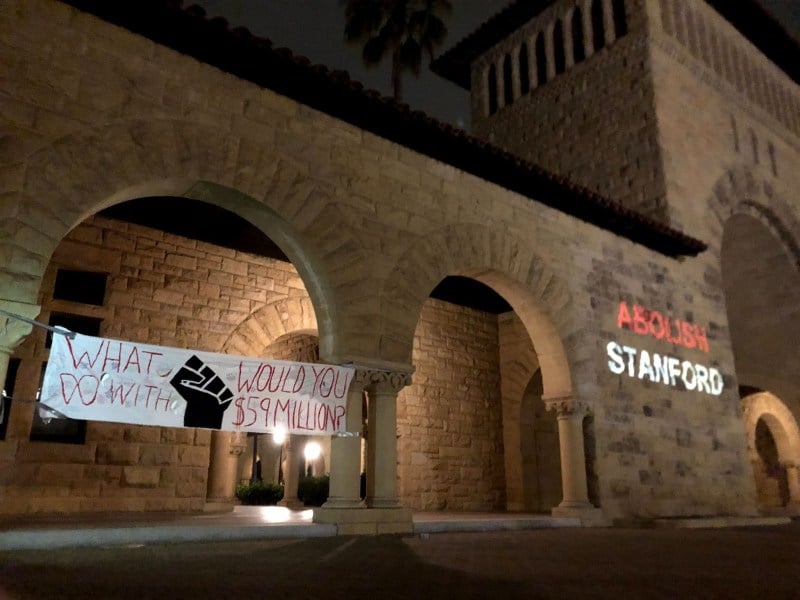Recently, former Provost John Etchemendy sent a letter to the editor in which he made several false and misleading claims criticizing Abolish Stanford and defending the Stanford University Department of Public Safety (SUDPS). Throughout the letter, Etchemendy demonstrated an ignorance of both student demands and abolitionist principles, arguing for a misleading position of “community safety” that relies fundamentally on carceral solutions.
The former Provost’s comments — which argue that we should “promulgate the standards and style of SUDPS nationwide” — are alarming in the context of SUDPS’s violent history. Etchemendy consistently positions SUDPS as an exception to the long history of police violence, but it was during his tenure as Provost that an SUDPS Deputy was involved in the murder of East Palo Alto resident Pedro Calderon at the base of Stanford foothills. No reparations were ever made to Calderon’s family, and Stanford — as Etchemendy’s own comments indicate — seldom acknowledges that the event occurred.
Etchemendy’s letter is part of a larger pattern to which we’ve grown accustomed: Administrators pay lip service to ideas of “equality” and “justice” while actively refusing to take any concrete steps to realize these ideals.
Last week, on the one-year anniversary of the murder of George Floyd by the racist Minneapolis Police Department, students received an email from four Vice Provosts that “thank[ed] our community centers, student leaders and student organizations for continuing a legacy of activism focused on the most vulnerable,” citing the Black Lives Matter memorial Abolish Stanford helped construct on the Oval last June, and recognizing “those creating change after so much unconscionable loss.” Conveniently, their email omitted the fact that when the BLM memorial was actually up on the Oval, we were repeatedly informed that we had to take it down, or the administration would take it down for us.
Acknowledging the importance of scrutinizing University messaging and uplifting the truth, we at Abolish Stanford would like to take the opportunity to respond to some of the wildy deceptive claims advanced in Etchemendy’s May 20 letter to the editor.
Etchemendy opens with the misleading assertion that a previous Daily article covering our Abolition May rally “does not recount any complaints” about SUDPS because the department “provides a blueprint of community policing.” His suggestion is that the Stanford community simply has no complaints about SUDPS. But as many, many, many op-eds in the Daily have already noted, this is categorically false.
Despite Etchemendy’s assertions that SUDPS officers are “familiar” with the needs of the student community, interactions between Stanford cops and students have routinely proven otherwise. Stanford police are not waiting in the shadows on Santa Teresa to get to know the community better; they are racially profiling and terrorizing Black students where they live. And when Stanford allows its police to respond to a student mental health call armed with guns holding rubber bullets — which can cause fatal nerve damage despite their label as “non-lethal weapons” — they prove that they have ignored the demands of the student community, who have consistently called for non-punitive, non-carceral responses to mental health crises. Regardless of Etchemendy’s perception, SUDPS police do not know nor support the needs of the student community.
Etchemendy’s misconception of “community policing” is not at all unique. Stanford is one of the over 95% of four-year colleges with a student population greater than 2,500 that has their own law enforcement agency; these schools justify the existence of their police forces with similar arguments. But, there are countless instances of racial profiling, brutality, sexual assault and murder by these supposedly exceptional police forces. Thus, when Etchemendy asserts that SUDPS officers are somehow more dedicated to ideas of community safety than the “swaggering big city cop,” he relies on an already-debunked myth of campus cop exceptionalism so as to disregard the violence that SUDPS has inflicted on countless communities on and off campus.
For a professor whose research interests include logic, Etchemendy’s characterizations of our demands are startlingly illogical. From day one, Abolish has advocated not only for defunding SUDPS, but abolition everywhere. Etchemendy only manages to make one correct observation: “Stanford does not have to maintain its own police force.”
As we revealed at our rally, of the 1,015 incidents SUDPS responded to in 2020, 89.7% were “nonviolent”, and 64% were simply closed with no action. Even in the 10.3% of incidents which were deemed “violent,” police were and continue to be incapable of preventing harm; they do nothing, or they escalate the situation. And yet, as Etchemendy indicates, it is an active administrative choice to funnel resources into this false form of “public safety.”
We are not advocating, as Etchemendy suggests, for a “utopian” solution. Abolition takes work. We understand that it does not happen in a vacuum, and that liberation must extend across the peninsula and center the demands of those who have been most heavily victimized by police violence.
Many students on campus already have no need for campus policing, an institution that serves mainly to protect the financial interests of the University and abuse and surveil communities of color. Public safety results not from million-dollar police budgets and capital projects, but by addressing the social roots of inequality and mental health, and by paying reparations to the surrounding communities that Stanford continues to gentrify, police and vilify.
This is the work we at Abolish Stanford are committed to doing, together. We have no need for policing because the police do not keep us safe; we keep us safe.
Abolish Stanford
